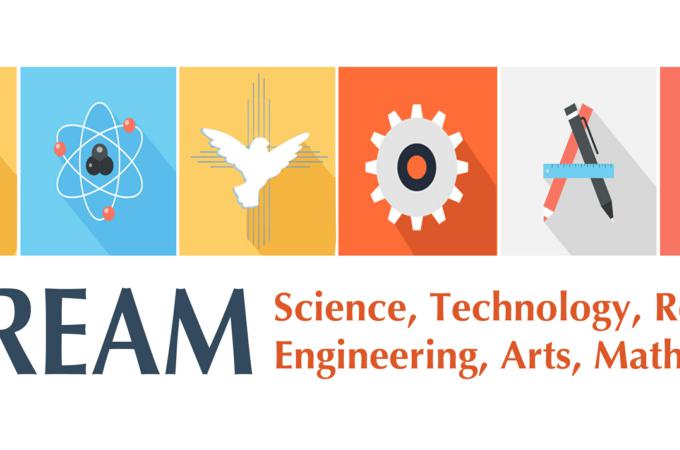Jumping into the STREAM
STREAM stands for Science, Technology, Religion, Engineering, Art and Mathematics and is a part of many of our schools on-going efforts to improve the instruction and curriculum that we offer to our students.
STREAM is the intentional integration of the individual disciplines of science, technology, religion, engineering, the arts and math in order to assist students in the development of communication skills, critical thinking, creativity and collaboration built on a foundation of our Catholic faith. While many public schools have STEM (Science, Technology, Engineering and Mathematics) programs, for Catholic schools STEM is not enough. Catholic schools believe in educating the whole child. We believe that exposure to the arts is essential if we are to develop our students and their abilities to create and think about music, art, drama and literature.
In the Archdiocese of Boston we are also dedicated to an educational experience that provides multiple encounters with Christ in every aspect of curriculum and instruction. We believe that when teachers begin with our faith and build lessons based on our faith, we are fulfilling our ministry as Catholic educators. STREAM helps us to achieve this goal.
STREAM schools look different. A visitor to a STREAM school will see our students involved in new ways that may include technology, but will definitely invite our students to think more critically and collaborate with their peers. STREAM classrooms are generally noisier, as students are expected to not only practice and improve their written communication skills but also their oral communication skills. Students are asked to solve problems while working with others. Student engagement in STREAM schools is focused so that students are able to learn not only specific content, but also the communication, collaboration, creativity and critical thinking skills necessary in our ever changing world.
Almost all of our schools have adopted a STREAM model for certain grade levels in their schools, if not their entire schools. Some schools are teaching coding through robotics to their kindergarten students and at the high school level, our schools are competing at robotics competitions and winning! They are designing, creating, collaborating, thinking and communicating at levels that are very sophisticated. These are lifelong skills that have been taught in our schools for a very long time, skills which are truly hallmarks of Catholic education.
One of the Kindergarten classrooms in the Archdiocesan Robotics Initiative is Holy Family in Rockland. Their Kindergarteners programmed their robot to visit countries, thereby combining the teaching of geography with the teaching of the coding curriculum. The students learned many things through this experience and are building a solid foundation for their future.
Our schools are also using technology to enhance their religion classroom. Recently, at St. Columbkille Partnership School, I witnessed 7th graders who were studying Scripture. They were learning about Jerusalem and where it was located in relationship to other places that Jesus visited and preached. They were doing it with 3D technology, so they were transported to these ancient places so they could see how it looks and how the geography played a role in the teachings of Jesus. As an adult, I was as engaged as the students, as I wore the glasses and felt myself transported to another continent. This use of technology enhanced the teaching of the religion lesson.
Sacred Hearts in Haverhill also has a STREAM program and for one of their school-wide projects, the students used Africa as the basis for their study. The students not only learned the geography of Africa, they also read traditional African stories, created African art work and learned about the work of Catholic Relief Services in Africa. The students also studied the Seychelles Islands and how most of the people who live there are Catholic. Students learned to say the Hail Mary in Zulu and prayed for Catholic school students in Africa.
Pope St. John Paul II, said in the "Catechesi Tradendae," #22, "Authentic catechesis is always an orderly and systematic initiation into the revelation that God has given of Himself to humanity in Christ Jesus, a revelation stored in the depths of the Church's memory and in Sacred Scripture, and constantly communicated from one generation to the next by a living, active tradition. This revelation is not, however, isolated from life or artificially juxtaposed to it."
We want our students to understand that faith is not a separate part of their lives, but rather woven into how they live and how they will eventually work. Efforts such as STREAM promote this idea. It helps us to teach our students that our faith is integral in the life of Catholics and it provides us with a framework in which we can live. Our schools are doing this work well and our students benefit from these experiences.
Jumping into the STREAM is a good thing for our students. It is helping us to enhance the teaching and learning process and it is providing our students with more ways to practice skills that they will use throughout their lives. Most importantly, STREAM initiatives assist us in teaching the faith. We are blessed to have great teachers who continue to look for new ways to teach our faith, teachers who are willing to wade into new waters to do what is best for our students.
- Kathy Mears is Superintendent of Catholic Schools in the Archdiocese of Boston.



















